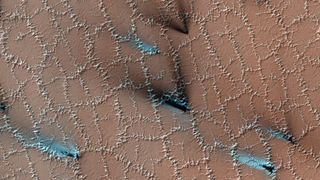Bizarre 'polygons' are cracking through the surface of Mars
Alien infrastructure, or just signs of spring?

It's springtime on Mars and the mysterious polygons are in bloom, a new image from the orbiting High Resolution Imaging Experiment (HIRISE) camera shows.
Recorded on March 30, 2022, the image reveals a patchwork of white zig-zags cracking across the Martian soil at high latitudes, with occasional sprays of black and blue mist fanning out between them. The zig-zags and colorful sprays are signature features of Martian spring, when hidden reservoirs of subterranean ice butt up against the dry Martian surface, researchers at the University of Arizona — which manages the HIRISE mission — wrote in a statement on Monday (June 20).
"Both water and dry ice have a major role in sculpting Mars' surface at high latitudes," the researchers wrote. "Water ice frozen in the soil splits the ground into polygons."
The edges of these polygons become cracked and frayed in springtime as surface ice transforms from a solid into a gas — a process known as sublimation. When this transformation occurs, vents of dry ice spray out of the Martian surface, leaving dark, fan-shaped deposits of particles spread across the ground, the researchers said. Where dark particles sink back into the dry ice on the surface, bright marks (seen as whitish-blue streaks in the image above) stain the ground.
A single ice vent can open and close multiple times, spraying particles in different directions across the Martian surface depending on the wind. That's why some areas show several different light and dark streaks jutting out of a single vent. Both the fans and polygons can stick around for many years, slowly warping the Martian landscape as ice expands and contracts seasonally.
The HIRISE camera rides aboard NASA's Mars Reconnaissance Orbiter, which began its mission in 2006. Soaring between about 155 and 196 miles (250 to 216 kilometers) over the planet, the orbiter has captured a treasure trove of bizarre and amusing images over the past few decades. For example, in 2018, the orbiter glimpsed a formation of rocks and craters that loo identical to the bug-eyed Muppet Beaker, meep-meeping near the Martian south pole.
Perhaps even more impressive are the orbiter's images of Valles Marineris, the largest canyon in our solar system (and therefore the largest known canyon in the universe). Spanning nearly 10 times as long as Earth's Grand Canyon and three times deeper, the canyon remains a mystery of Martian geology; scientists aren't really sure how it formed. If any Muppets were involved, they're keeping the truth to themselves.
Sign up for the Live Science daily newsletter now
Get the world’s most fascinating discoveries delivered straight to your inbox.
Originally published on Live Science.

Brandon is the space/physics editor at Live Science. His writing has appeared in The Washington Post, Reader's Digest, CBS.com, the Richard Dawkins Foundation website and other outlets. He holds a bachelor's degree in creative writing from the University of Arizona, with minors in journalism and media arts. He enjoys writing most about space, geoscience and the mysteries of the universe.
